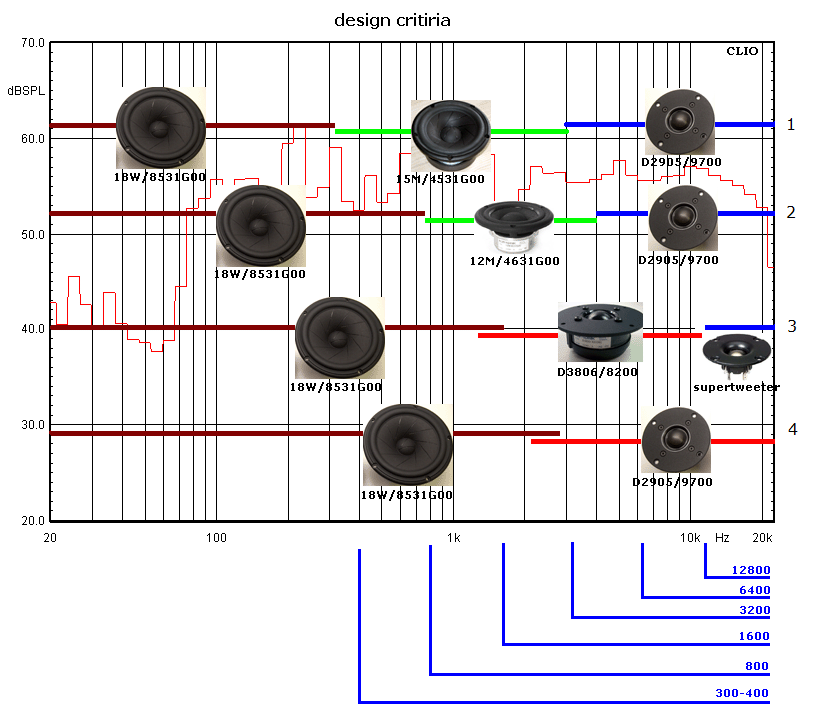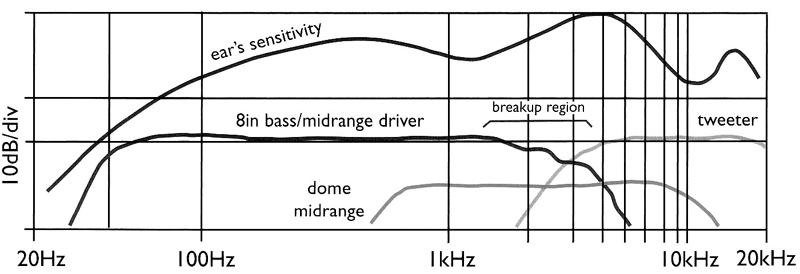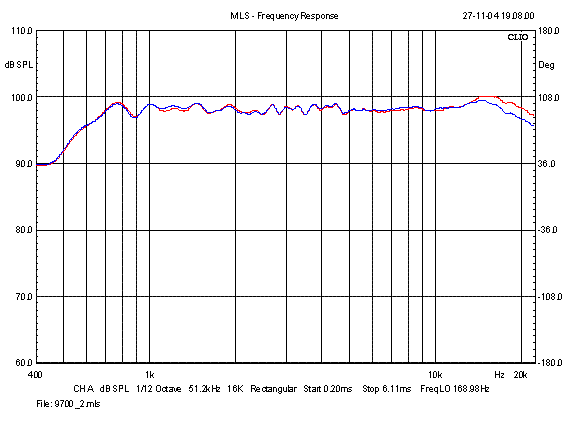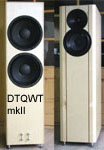Design Criteria
Copyright 2009-2014 © Troels Gravesen
How do we choose optimal points of crossover for 2- and 3-way constructions?

There are many ways of combining drivers with regard to
point of crossover and there is no definitive way of doing so. It's all
about compromises, and for many people cost is an issue too. Generally I
find a small 4" driver filling the gap between bass and tweeter
beneficial, but it comes at extra cost and increased complexity of
crossover.
The one obvious thing that determines the use of a given driver is it
frequency range, but despite a small 3½-inch driver being able to cover
down to 200 Hz doesn't mean we're going to do so because the membrane
size simply doesn't allow very loud sound levels. And the same driver
may be able to cover up to 12 kHz and it doesn't mean we will use it
that high, because due to the membrane diameter it will start beaming at
4-5 kHz and beaming doesn't sound good. In addition to this, the slope
of the crossover is another factor to consider. A 4" driver may do well
down to 700-800 Hz from a 2nd order filter but may actually be capable
of handling down to 400 Hz from a 4th order filter.
This pretty much leaves practical experience as a key factor. So, go
build some speakers with various topologies and find out for yourself
what suits your drivers and taste the best.
Example
1
is the traditional 3-way utilising a 6-8” woofer, a 4-5”
midrange driver working from around 350 Hz to 3-4 kHz and a 1” tweeter
handling treble from around 3 kHz to 20 kHz.
Some people will take the 4-5” down to 150 Hz, but to my mind we are
then talking satellites + subwoofer. If we want the midrange driver to
handle upper bass/lower midrange we need a 6” driver.
Example
2
is not too common approach – a classic – using a 3-4” driver
from around 800 Hz to 3-4 kHz, and a ¾”-1” tweeter up to 20 kHz. Some
20-40 years ago this was a standard way of mating bass and tweeter
drivers, and it definitely has its merits. See below. This is taken from
a recent issue of HiFiWorld and displays the ear's sensitivity and
strongly suggests that keeping away from the 1.5-4 kHz region may be an
advantage. This is very much in line with the SP38, SP44, TJL-3W, Ekta,
SEAS Classic 3-Way and ScanSpeak Discovery 3-Way.
A 3” driver may do well down to 500 Hz but when used from only 700-900
Hz it has an ideal size for handling upper-mid and lower-treble. At 4
kHz the wavelength is 8.6 cm.

One reader has pointed out that taking the point of crossover between mid and tweeter up to 4 kHz does not remove this "problem" out of the range critical to the ear's highest sensitivity. 4 kHz is actually right at the peak of the ear's sensitivity. True! I have no definitive explanation for the subjective benefits of adding a small upper midrange handling the 800-4000 Hz range compared to a 1" dome going down to e.g. 2 kHz other than the change in dispersion from a 6" to a 1" dome is significant and a small driver in-between helps smoothing this transition in dispersion.
Spendor, Peak Consult and Verity Audio have no trouble (?) taking a suitable midrange driver up to 3800 Hz - and with apparent success. And I'm sure that the choices they have made are very well considered. They simply want to have one single driver handling the entire midrange and lower treble to get rid of this problem. However, taking a 5" AudioTechnology driver up to 3800 Hz does have an impact on the overall voicing of a speaker. I've tried taking my AudioTechnology 4H52 up to 4500 Hz crossing over to a SS 9500 treble unit (4th order slopes) and I wasn't too thrilled. The dispersion from a 100 cm^2 cone at 4 kHz is not the best, but possibly a 2nd order filter will make a suitable blend of sounds to enhance the midrange driver's limited ability to perform well at such high frequencies.Comments are welcome.
Example
3
is the SP38/13 approach and to my knowledge not much used, if
used at all. And it’s a pity, because few 6-7” drivers handle well above
1500 Hz. Well, some 6-7” kevlar and polypropylene drivers have a
tolerable presentation above 2 kHz with a smooth roll-off with no
disturbing peaks to spoil the treble quality. But large cones start
beaming when having to handle higher frequencies and very few drivers
get away with it successfully – or we may have to use low order filters
to make a blend of sounds from the midbass and treble thus overcoming
some of the shortcomings of the midbass driver.
Drivers like the ScanSpeak D3806/8200 are rare and I haven’t been able
to find an exact replacement that will basically handle the frequency
range from 1,000 – 13,000 Hz.
I’m sure that some will object here, shake their heads and tell me
there’s no problem in taking a 1” dome down to 2 kHz, so why the agony?
And this is true; the 9700 tweeter goes clean down to 800 Hz - but to my
ears it shouldn't.

What I have left out in this presentation is the true
middome*, although the 3” 12M/4531G00 actually is a kind of middome, a
large voice coil carrying a large paper dome and a narrow cone
connecting the dome to the surround. Fortunately this driver uses a very
small magnet (neodymium?), has a vented pole piece and should have
proper rear ventilation. Not an easy thing to make when drivers get this
small.
*: Forget the 3" Vifa middome. The old Dynaudio D52s were good and so
are the horrific expensive middomes from ATC.
Example 4 is the all-time classic. A 6” midbass and a 1” dome, usually with a point of crossover around 2,000-3,000 Hz. This is obviously the most cost-effective way of getting it all from two drivers. Simple crossover – if the drivers are performing well – simple cabinetry, no need for middriver housing, etc.
As can be seen we’re moving in octaves here:
400-800-1600-3200-12800. Well, I have never seen a point of crossover at
6,400 Hz (except for horn loaded compression drivers) as few tweeters
have trouble handling 3 octaves from 3 kHz to the limit of audibility. A
good upper-middome like the D52 may be able to handle a p.o.c. around
5.6 kHz, but I’ll leave out this option here.
The points of crossover are serious choices to be made and we have to
consider basic frequency response, cone area, dispersion and power
handling to mention a few parameters. The most important - unfortunately
- is experience.
Bigger speakers




You may have noticed that none of my bigger
speakers use any small 3-4" upper-mid driver between the 6" midrange and
1" dome. Neither does commercial speakers, at least the vast majority.
Chario is one
manufacturer that actually adds a 4" driver ("130 mm") in between
midrange and tweeter in their larger speakers.
The thing is that when a 6" driver no longer has to cope with bass, the
performance in upper-mid/lower-treble (640-2560 Hz) is significantly
improved and the benefit of adding a small driver becomes questionable -
and makes cabinet construction and crossover more complex and costly.
The examples above are quite different. The DTQWT is basically a 2-way with subwoofers and features a large 8" driver for upper bass and midrange and a large 1½" dome. Due to the wave-guided tweeter it features and seamless integration of upper-mid/treble and holds the indisputable benefit of not having a crossover (series capacitors) to the midrange. The DTQWT has a midrange coherence even the ATS4 cannot deliver.
The ATS4 is having the bass punch of a closed cabinet speaker combined with the low-end extension of a vented construction. And this from a moderate sized speaker. Point of crossover between bass and mid is just below 200 Hz. If the mid-driver had to be taken lower the price to pay would be decreased overall sensitivity as the 6" driver on such a small baffle suffers baffle step loss.
The Jenzen Illuminator is the classic 10+6+1 set-up and points of crossover are again 200 and 2000 Hz. One problem with this kind of speaker is cost of the midrange series capacitors. We need a lot of uF and they better be good, thus 500 EUR just for these two banks of 88 uF capacitance.
The OBL-11 is special and I don't know of any commercial speaker based on these design criteria as WAF is an all-time low. Points of crossover are still 200 and 2000 Hz and with it's 15" bass driver and midrange high-pass filter it can blow your brains out.
I would like to take the point of crossover to the middriver lower, like 120-140 Hz, but the trade-offs are loss of power handling and system sensitivity. There is an awful lot of energy in the 100-200 Hz range and if I had to go down to 120 Hz I would use two 6" drivers like the Wilson Audio Alexandria XLF speaker.